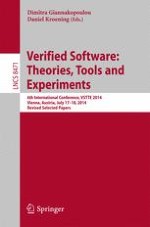This volume constitutes the thoroughly refereed post-conference proceedings of the 6th International Conference on Verified Software: Theories, Tools and Experiments, VSTTE 2014, held in July 2014 at the Vienna Summer of Logic in Vienna, Austria, as an associated event of CAV 2014, the International Conference on Computer-Aided Verification. The 17 revised full papers presented were carefully revised and selected from 34 submissions. The papers are organized in topical sections such as analysis: understanding and explanation; verification frameworks and applications; hypervisors and dynamic data structures; certification; real time and security.

